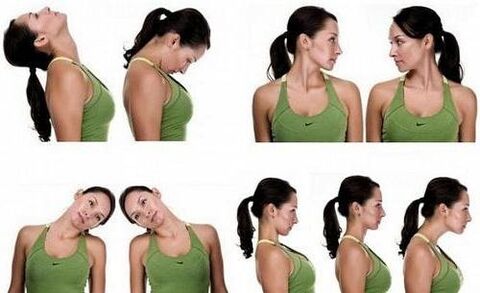Osteochondrosis of the cervix is one of the most common pathologies of the musculoskeletal system. Every year doctors diagnose this disease more and more often and it is becoming more and more acute. According to statistics, degenerative-dystrophic changes in the upper part of the spine occur more often in women, especially in patients during the postmenopausal period. The main symptoms of cervical osteochondrosis in women are pain, limited mobility, cerebral circulatory failure, and it is dangerous not only for health but also for life. To protect yourself from the dangerous consequences of pathology you should start treatment in the early stages. It is important to conduct complex therapy, lifestyle changes to stop the destruction of the spinal segments and to avoid serious complications.
Development of the disease
The cervical spine is most vulnerable to various lesions and degenerative changes. This is due to the fact that this segment is the most mobile and the muscles here are weak. The cervical vertebrae can withstand severe stress every day, leading to the gradual destruction of the intervertebral discs. Spinal presses threaten each other, causing the cartilage pads between them to lose a lot of fluid, starting to degrade and deform.
In addition, osteochondrosis of the cervical spine develops due to insufficient nutrition of cartilage tissue. And the spinal canal is narrow in this area, so it often stretches, causing neurological symptoms.
At an early stage, the pathology is manifested in women in the back of gravity, tingling in the hands, and so on. Sh. Often, patients confuse the first signs of the disease with congestion.
A large number of blood vessels and nerve roots are located in the neck area, and when they are compressed, neurological disorders can also occur. It is especially dangerous if a deformed disc or spine compresses the vertebral artery, which feeds important parts of the brain. When it expires, coordination of movements is disrupted, a woman can lose balance, deteriorate vision and hearing, and increase the risk of stroke.
Reference. According to statistics, the most common cervical osteochondrosis is found in patients aged 25-40 years. This is caused by a massive reduction in physical activity, with sedentary work. Women are more likely to be diagnosed with the disease than men because they have more fragile spines and thin bone tissue.
Doctors distinguish 4 stages of osteochondrosis store:
- Stage 1 - The intervertebral disc loses some moisture, its height decreases, cracks may appear on the fibrous ring (outer membrane). This is a stage of cervical chondrosis that is difficult to identify since it has pronounced symptoms. The neck gets tired quickly, there is discomfort, heaviness in the injured area, sometimes there is a slight pain that passes quickly.
- Stage 2 - Cracks grow on the surface of the disc, the nucleus pulposus (disc gel-like contents) moves, may pass through the damaged areas. This is how a cartilage protrusion occurs, which can compress the spinal cord and its roots. Periodically, severe pain, weakness, limited mobility, numbness of the face, neck, shoulders, arms may be noted.
- Stage 3 - The protrusion breaks the outer membrane of the disc, so a hernia is formed. The pain is more pronounced, there are neurological disorders.
- Stage 4 - The disc is almost completely destroyed, the spines are pulled together, bone formations (osteophytes) appear on their edges, which are designed to stabilize the damaged segment. Disrupted nerve endings, spinal cord, blood vessels. Damage to nearby joints begins. Clinical signs are pronounced.
In the first two stages of osteochondrosis of the store, it is easiest to stop the degenerative-dystrophic changes. In the 3rd stage, complex treatment will help stop further destruction of the spinal segment. You can not do without surgery in the last stage.
ᲛReasons
Osteochondrosis store is a complex and lengthy process that most often has several causes. In most cases, the pathology occurs as a result of a sedentary lifestyle, poor nutrition, metabolic disorders. Often, the disease occurs due to trauma or natural aging of the body and weakening of its defenses.
Doctors identify the main causes of osteochondrosis in women:
- Disruption of metabolic processes.
- Passive lifestyle.
- ᲒNetic predisposition.
- Chronic muscle tension around the cervical segment.
- Posture curve.
- Deficiency of fluids and nutrients in the body.
- Prolonged stay in an uncomfortable position (neck extended forward and back bent).
- Excess weight.
- Wearing frequent high-heeled shoes.
- Store injuries.
- Lifting heavy objects.
- Autoimmune pathologies.
- Frequent stress, chronic fatigue.
- Hypothermia.
- ᲘInfectious diseases.
- Neck too long or too short, & c. Sh.
All of these factors lead to malnutrition of the intervertebral discs and lead to their degeneration.
Osteochondrosis of the cervix of a woman can be caused by pathologies of the vertebral artery, which are associated with genetic predisposition, intrauterine disorders, trauma during childbirth. The disease can occur as a result of rheumatism, endocrine disorders, excessive loading of the cervical segment during pregnancy, local overload.
ᲛImportant. The main cause of cervical osteochondrosis in women is menopause as well as the changes associated with this period. At this stage, the concentration of progesterone in the body decreases, which is very important for bone tissue. The likelihood of degenerative changes is related to age-related weakening of the neck muscles and weakening of the spine in this area.
Symptoms
Osteochondrosis is characterized by a wave-like course when the acute period is replaced by remission. Exacerbation can provoke infections, injuries, hypothermia, prolonged stress on the neck.

The first signs of cervical osteochondrosis in women are headache, discomfort, heaviness in the neck. Timely diagnosis of chondrosis pain from migraine or autonomic dysfunction.
SHOP Clinical manifestations of osteochondrosis in women caused by neurological syndromes:
- Cervical discalgia occurs when nerve endings are irritated by fragments of damaged cartilage. Then there is a specific crisis of the neck, a pain that manifests itself more sharply when moving and after sleep.
- Scale muscle syndrome occurs as a result of damage to the vessels and nerves of the brachial plexus and subclavian artery. This complex of symptoms is accompanied by pain from the inner surface of the shoulder to the injured side of the hand. The limb becomes pale, cool, swollen, numbness occurs. Neck pain spreads to the back of the head when the patient turns his head.
- Shoulder-Scapular Periarthritis Syndrome - Dystrophic changes affecting the tendon fibers that surround the shoulder. Painful sensations from the neck radiate to the shoulder and shoulder girdle. The neck is in a forced position - it is tilted towards the affected side while the arm is slightly lowered.
- Spinal Artery Syndrome - The blood vessel is compressed by fragments of a damaged disc or osteophytes (it depends on the stage of the disease). The patient has dizziness and has headache, nausea, sometimes vomiting. The pain is localized in the occiput, crown, and temples.
- Cardiac - spinal cord nerve bundle damaged. Here is heartburn, arrhythmia. If C3 is damaged, pain appears in the middle of the neck, the tongue swells, the patient can not chew food normally. If C4 is injured, then discomfort occurs in the shoulder girdle, supporting bone, heart area. By defeating C5, the neck pain reaction spreads to the shoulder girdle, the inner surface of the shoulder. Irritation C6 manifests itself from pain from the neck and veins to the shoulder girdle and extends throughout the arm to the thumb. If C7 is damaged, the pain syndrome extends to the back of the shoulder girdle, covering the entire hand, including the index and middle fingers. When C8 is contracted, the pain extends from the affected area to the elbow and little finger.
Also, a woman's emotional sphere can be broken, weakness arises, she worries, feels. Insomnia often occurs, memory and attention are weakened due to regular headaches.
Symptoms of a cerebrovascular accident occur when a woman suddenly throws herself back, tilts her, or performs work that loads on her arms and cervical spine, such as when she digs, paints a ceiling, and carries weight.
Cerebral circulatory disorders are manifested by dizziness, abnormal gait, "flying" in front of the eyes, tinnitus, weakness, nausea. In some patients the voice sounds, sometimes disappears, sore throat appears.
Osteochondrosis during menopause is accompanied by migraine, increased body sweating between the neck and shoulder girdle. Compression of the vertebral artery disrupts the work of the cardiovascular system.
If the disease persists for a long time, then there is a lack of blood circulation to important centers that perform neuro-endocrine functions. Due to the increased permeability of the blood vessel walls, atherosclerosis of the cerebral and cardiac arteries develops.

Make a diagnosis
If you notice symptoms of osteochondrosis, then consult a therapist. After a visual examination, a specialist will refer you to an orthopedist, vertebrologist, or neurologist.
The following methods are used to diagnose cervical osteochondrosis:
- X-ray allows you to find out that the patient has moved the vertebrae, there are osteophytes on their edges, the distance between the vertebrae is reduced. To do this, research is conducted in different plans. To confirm the characteristic changes, the doctor takes pictures of the view.
- Cervical spine CT provides detailed information about abnormal changes in the spine. This method allows you to get volumetric images for a more detailed study, it is used in severe diagnostic cases.
- MRI is used to accurately assess the condition of soft tissues (nerves, blood vessels, joints, muscles) in the affected area.
- Electromyography allows you to check the conduction of nerve fibers.
Doctors may also order Doppler ultrasound (Doppler ultrasound of the large arteries of the brain) to determine the state of blood flow to this site.
Conservative treatment
Early stage osteochondrosis treatment in the store can be done at home. In addition, the physician should establish a therapy regimen. It is important to understand that this is a long process and it is unlikely that it will be completely cured (especially for older women).
Complex treatments include:
- Taking medication.
- Use of orthopedic devices.
- Physiotherapy.
- Physiotherapy procedures.
- Massage, hand impact.
- Alternative treatment.
Conservative techniques will help stop pain, inflammation, normalize muscle tone, metabolic processes, nourish the damaged segments of the spine. With timely therapy it is possible to stop abnormal changes.

Cervical osteochondrosis remedies can help get rid of inflammation and pain.
Treatment of cervical osteochondrosis in women is carried out using medications that will help the spinal bones to move between the vertebrae, stop inflammation, relieve pain. The following drugs are used for this purpose:
- Nonsteroidal anti-inflammatory drugs. May help relieve mild or moderate inflammation and pain.
- Analgesics. The pain is relieved.
- Preparations to improve cerebral circulation.
- Muscle relaxants help relieve muscle spasm.
- Chondroprotectors. They help destroy the disc, improve metabolic processes and accelerate recovery.
- Magnesium-based medications.
- Nootropics. They stimulate brain work by normalizing blood circulation, have a mild sedative effect.
Reference. In intense pain, which is not relieved by oral medications, therapeutic blockades are used, for example, with a solution of novocaine or nonsteroidal anti-inflammatory drugs.
Treatments can be supplemented with anti-inflammatory and analgesic gels, creams and ointments. They will be effective in remission or in combination with oral remedies.
The decision to choose medication combinations is made by your doctor. The specialist will develop a medication regimen and also determine their dosage. It is important to follow his recommendations, as many of the medications listed above are fraught with dangerous complications.
In the acute stage of osteochondrosis of the store, a woman should give up heavy physical activity. To unload the cervical segment, you need to wear a special corset (shunt collar) that will fix the malleolus in the correct position. This device is recommended for prolonged sitting or heavy physical work.
Physiotherapy procedures will help relieve pain and improve blood circulation to the injured area:
- Diadynamic therapy.
- Magnetotherapy.
- Electrophoresis.
- Electroanalgesia.
- Ultraviolet radiation and a. Sh.
The therapeutic effect is manifested after about the third session, then headaches, hearing disorders, visual disturbances, dizziness, sleep normalization or disappearance, and the general condition improves.
By subcutaneously pulling the cervical segment, it is possible to widen the distance between the spine, release the nerve or blood vessel from the contraction, and restore the normal position of the spine.
Massage normalizes muscle tone, reduces the flow of lymphatic fluid, causing swelling. After a few sessions, blood circulation to the affected area improves.

Therapeutic gymnastics is one of the most effective methods of treating osteochondrosis in the store. Exercise therapy allows you to strengthen the weak muscles of the neck, which will then take some load from the spine and help to stop or slow down the degenerative-dystrophic changes. During classes, blood circulation is improved, metabolic processes, nutrition of the discs is accelerated, which has a positive effect on their condition.
Women should exercise every day. They consist of simple but effective exercises. The complex consists of turning, tilting the head in different directions, as well as neck movements in which the hands are used. These elements can be performed at home, but only with a doctor's permission. Physiotherapy exercises are conducted only in the remission phase.
Reflexology (acupuncture), hirudotherapy (tropical therapy), swimming, etc. can be added to the complex treatment. Sh.
Surgery
Surgery is prescribed in the final stages of osteochondrosis of the store, accompanied by severe destruction of osteochondral structures. Also, surgical intervention is necessary if conservative techniques are ineffective or the spinal canal is severely narrowed.
In the cases described above, anterior cervical discectomy is performed. During the procedure, the doctor immobilizes the damaged segment of the spinal column and removes the hernia that has compressed the spinal nerve. Then the vertebrae between which the disc was removed are combined. If necessary, the space between the vertebrae is filled with a synthetic insert (cage).
After 3-5 days the patient was discharged home. The rehabilitation period is about 12 weeks. Accelerating recovery requires taking medication, wearing a corset, a healthy lifestyle, undergoing physiotherapy procedures, and finally exercise therapy.
Lifestyle recommendations
In order to quickly get rid of the unpleasant symptoms of osteochondrosis and stop the degenerative-dystrophic changes in the cervical segment, you need to change your lifestyle. To do this, the patient should follow the following recommendations:
- Take daily walks, avoid jogging, jumping and other explosive activities.
- Heavy items should not be worn.
- You can not sit for long, in extreme cases, wear a corset and periodically catch a horizontal position.
- Perform specific physical exercises for the spinal muscles at home.
- Sleep on an orthopedic mattress and a special pillow.
- Follow a diet, complete the diet Foods rich in magnesium, calcium (nuts, dairy products, seafood, legumes), as well as fiber, chondroitin (jelly meat, jelly). Avoid fatty, fried, very salty foods, alcohol. Your doctor will advise you more about eating rules. In any case, it has to be right.
Hypothermia is not allowed, warming will be useful in the absence of inflammatory process.
Complications
In the absence of timely treatment of cervical osteochondrosis, a woman may experience the consequences of the following pathology:
- The probability of a protrusion that transforms into a hernia after a while. The bulge compresses the spinal cord as well as its nerves, causing neurological damage.
- Osteophytes appear during severe damage to the disc; They irritate the spinal nerves and blood vessels.
- In advanced cases, there may be severe weakness or incomplete paralysis of the neck muscles, followed by involuntary leaning on the side or front.
- Compression of the vertebral arteries, disruption of blood circulation in the affected area. This condition can cause neuralgia (pain on the nerve pathway), hearing and vision loss.
- Paralysis of the hands (incomplete or complete).
- Stroke.
If a woman considers the issue in the early stages of osteochondrosis store, then she can avoid the above conditions.
Preventive measures
Ideally it is necessary to participate in the prevention of osteochondrosis of the store even during the period of intrauterine development. The expectant mother should rule out factors that negatively affect fetal development: infections, oxygen starvation, intoxication. If a birth injury has occurred, the newborn should be treated.
To reduce the likelihood of developing osteochondrosis store, a woman should consider the following recommendations:
- Load the spine evenly, for example, moving the load with both hands or alternately to the right and then to the left.
- Do not lift too much weight yourself.
- Try to avoid neck injuries, hypothermia.
- When working in garden plots, take a break every 1, 5 hours, rest for 20 minutes.
- Choose shoes with cushioned soles that are reflected on the cushions during running or jumping.
- When sitting for a long time, use a high back seat with a headboard, or wear a corset.
It is also important to eat right, control weight, avoid stress, take vitamin supplements for medical reasons, treat pathologies that can lead to timely osteochondrosis. During the remission phase, it is recommended to visit the sanatoriums for a course of treatment.
ᲧMost important
As you can see, osteochondrosis of the cervical spine is more common in women than in men because they have more fragile vertebrae and thinner bone tissue. Patient pathology is particularly sensitive during the postmenopausal period. The disease is manifested by pain, neurological disorders, and dangerous symptoms of a cerebrovascular accident. Initiation of treatment is recommended in the early stages to avoid dangerous complications of osteochondrosis. To do this, a woman must take medication, change her lifestyle, attend physiotherapy procedures, massage and do physiotherapy. Surgical treatment is shown only in advanced cases. To prevent pathology it is necessary to maintain moderate physical activity, timely treatment of injuries and diseases that can provoke osteochondrosis.














































